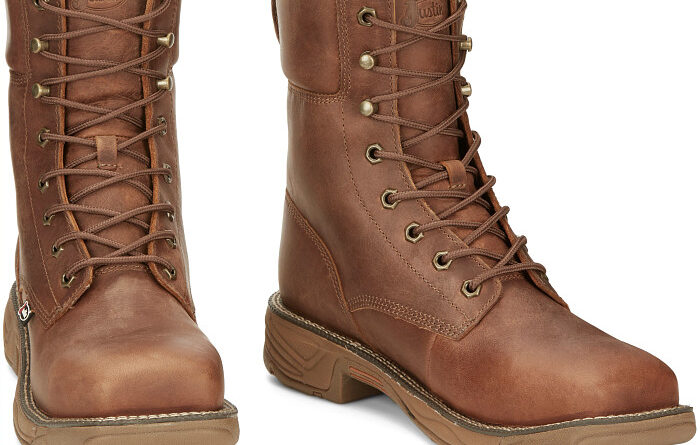
This post may contain affiliate links which means I may receive a commission for purchases made through links. Learn more on my Private Policy page.
Top 10 Work Boots for Roofing
Roofing work can be challenging, especially if you don't have the right footwear. That's why it's important to invest in a pair of high-quality work boots that not only provide comfort but also offer the necessary safety features for the job. Here are the top 10 work boots for roofing that you should consider.
Safety Features
When working on a roof, safety should be your number one priority. Look for boots that have reliable safety features such as reinforced toe caps and shanks for protection against falling objects. Additionally, boots with non-slip outsoles will help you maintain stability on slippery surfaces.
Durability and Material
Roofing work can be tough on footwear, so it's crucial to choose boots made from durable materials like leather or synthetic materials that can withstand the demands of the job. A sturdy construction will ensure that your boots last longer, saving you money in the long run.
Comfort and Fit
Roofing is physically demanding work, so it's important that your boots provide the right level of comfort and fit. Look for boots with cushioned insoles and sufficient arch support to minimize foot fatigue. Adjustable lacing systems and padded collars also contribute to a snug fit, preventing blisters and discomfort.
Toe Protection
Roofing involves handling heavy materials, so it's important to protect your toes from potential injuries. Boots with steel or composite toe caps provide extra protection against impact and compression, keeping your feet safe on the job.
Slip Resistance
Roof surfaces can be slippery, especially during wet or icy conditions. Look for boots with slip-resistant outsoles that offer excellent traction on various surfaces. This feature will help prevent slips and falls, ensuring your safety while working.
Waterproofing
Roofing work often exposes you to the elements, and damp feet can be uncomfortable and increase the risk of foot-related issues. Invest in boots with waterproofing features, such as sealed seams or water-resistant materials, to keep your feet dry and comfortable, even in wet conditions.
Insulation
Roofing work may sometimes be performed in cold weather, so it's important to choose boots with insulation to keep your feet warm. Look for boots with insulating materials like Thinsulate or fleece lining to provide warmth without compromising comfort.
Breathability
In warmer weather, your feet may get hot and sweaty. Choose boots with breathable materials such as mesh panels or moisture-wicking linings to allow air circulation and keep your feet cool and dry throughout the workday.
Lightweight
Roofing work often requires agility and maneuverability, so heavy boots can hinder your performance. Opt for lightweight boots that offer the necessary support and protection without weighing you down.
Price
Finally, consider your budget when choosing work boots for roofing. Look for boots that offer the best value for money, considering the quality, features, and durability they offer. Remember that investing in a good pair of boots is a wise decision that will pay off in terms of comfort and durability.
When it comes to roofing work, investing in the right pair of work boots is crucial. Look for boots that have the necessary safety features, are durable and comfortable, provide toe protection and slip resistance, are waterproof and insulated, offer breathability and lightweight performance, and fit within your budget. By prioritizing these factors, you'll be able to find the perfect pair of work boots that will keep you safe, comfortable, and productive on the job.
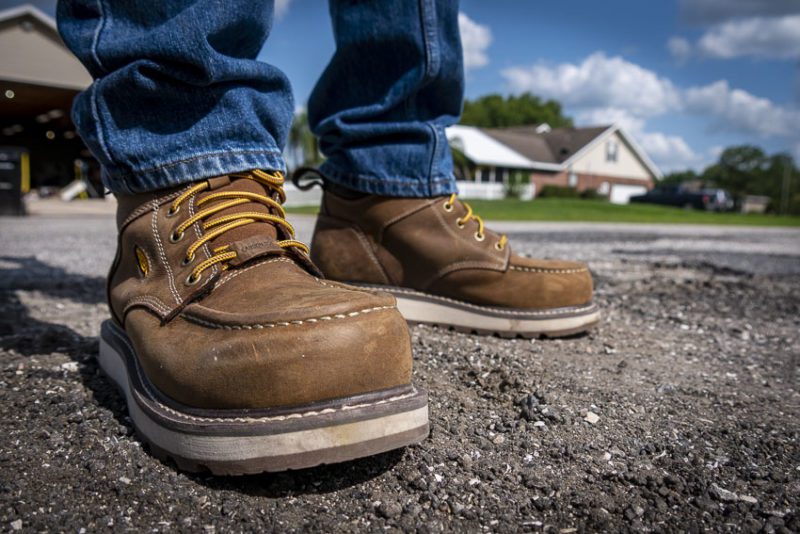
This image is property of www.protoolreviews.com.
## 1. Safety Features
When it comes to roofing, safety should always be your top priority. The right pair of work boots can provide you with the protection you need to stay safe and comfortable on the job. In this section, we will explore the different safety features to look for in work boots for roofing.
1.1 Steel Toe Boots
Steel toe boots are a must-have for any roofing job. These boots feature a reinforced steel cap in the toe area, which provides excellent protection against falling objects or accidental impacts. The steel toe design not only enhances safety but also adds durability to the boots.
1.2 Electrical Hazard (EH) Rating
Roofing often involves working around electrical systems, which makes an electrical hazard (EH) rating crucial. Boots with this rating provide insulation against electrical shocks, reducing the risk of electrical accidents.
1.3 Metatarsal Guards
Metatarsal guards offer additional protection to the upper foot and toe area. These guards cover the delicate bones and tendons in the metatarsal region, minimizing the risk of injury from heavy tools or equipment.
1.4 Composite Toe Boots
Similar to steel toe boots, composite toe boots also offer toe protection but with a lighter and non-metallic construction. These boots are ideal for workers who need toe protection but want to avoid the weight of steel.
1.5 Puncture Resistance
Roofing often exposes workers to sharp objects such as nails and screws. Look for boots with puncture-resistant features, such as thick outsoles or plates, that can withstand sharp impacts and prevent injuries.
Investing in work boots with these safety features can significantly reduce the risk of accidents and ensure your well-being while working on roofs.
When it comes to choosing the best work boots for roofing, durability and material are key factors to consider. Roofing jobs often involve harsh and demanding conditions, so it's crucial to invest in boots that can withstand the elements and provide long-lasting performance.
2.1 Leather Work Boots
Leather work boots are a popular choice for roofing due to their exceptional durability and resistance to wear and tear. They offer superior protection against cuts, abrasions, and punctures, ensuring that your feet remain safe and secure throughout the day. Additionally, leather boots are known for their breathability, allowing your feet to stay cool and comfortable even when working under the scorching sun.
2.2 Synthetic Work Boots
Synthetic work boots are another excellent option for roofing professionals. Made from a combination of synthetic materials, these boots are lightweight, flexible, and offer great waterproofing capabilities. They are designed to keep your feet dry and comfortable, effectively preventing any potential discomfort caused by damp or wet conditions.
2.3 Rubber Outsoles
Roofing often involves walking on slippery surfaces, making rubber outsoles a crucial feature to look for in work boots. The high-traction rubber soles provide excellent grip, allowing you to maintain stability and prevent slips and falls, even on steep inclines or wet rooftops.
2.4 Reinforced Stitching
To ensure the longevity and durability of your work boots, pay attention to the quality of the stitching. Look for boots with reinforced stitching, as this adds strength and stability to the construction. Reinforced stitching helps to prevent the boots from coming apart at the seams, even during heavy use and strenuous activities.
2.5 Abrasion Resistance
Lastly, consider the abrasion resistance of the work boots. Roofing jobs often involve contact with rough surfaces, such as shingles or metal sheets, which can cause significant wear and tear over time. Opt for boots with abrasion-resistant features, such as reinforced toes or toe guards, to protect against potential damage and prolong the lifespan of your footwear.
When choosing work boots for roofing, prioritize durability and material. Leather and synthetic boots offer excellent protection, while rubber outsoles, reinforced stitching, and abrasion resistance are key features to consider. By investing in top-quality work boots, you can ensure the safety and comfort of your feet throughout long hours on the job site.
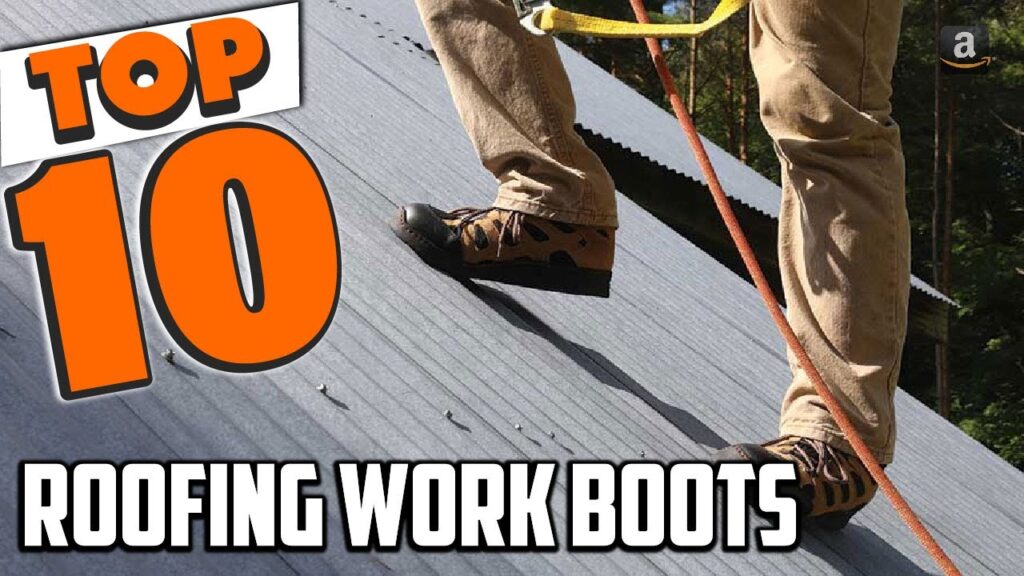
This image is property of i.ytimg.com.
## 3. Comfort and Fit
When it comes to choosing the best work boots for roofing, comfort and fit are crucial factors to consider. You want a pair of boots that will keep your feet comfortable and supported throughout long days on the job.
3.1 Arch Support
Good arch support is essential for roofers who spend hours standing on their feet. Look for boots with built-in arch support that will help prevent foot fatigue and provide proper alignment for your feet.
3.2 Cushioning
Roofing can be a physically demanding job, so having boots with ample cushioning is essential. Look for boots that feature cushioned insoles or midsoles to provide extra comfort and shock absorption, reducing strain on your feet and joints.
3.3 Ankle Support
Roofing often requires working on uneven surfaces and climbing ladders, so having proper ankle support is crucial. Look for boots that offer firm ankle support to minimize the risk of sprains or injuries.
3.4 Shock Absorption
Roofing involves constant impact and pressure on your feet, which can lead to discomfort and fatigue. Look for boots with shock-absorbing features, such as rubber outsoles or gel inserts, to minimize the impact on your feet and joints.
3.5 Sizing and Wide Fit Options
Ensuring a proper fit is essential for overall comfort and foot health. Look for boots that offer a variety of sizing options and wide fit options to accommodate different foot widths and shapes. Having the right fit will prevent blisters, hot spots, and discomfort while working.
Remember, when choosing work boots for roofing, prioritize comfort and fit. Your feet will thank you for investing in a pair of boots that provide proper support, cushioning, and sizing options.
4. Toe Protection
When it comes to roofing, toe protection is crucial to ensure your safety and prevent any potential accidents. So, what are the best work boots for this specific task?
4.1 Steel Toe vs Composite Toe
Work boots for roofing typically come with either a steel toe or a composite toe. Steel toe boots offer excellent protection against heavy objects and are highly durable. On the other hand, composite toe boots are made from non-metal materials such as Kevlar or carbon fiber, providing a lighter and more comfortable option without compromising safety.
4.2 ASTM F2413-18 Standard
To ensure the highest level of protection, it's essential to choose work boots that meet the ASTM F2413-18 standard. This standard establishes performance requirements for protective footwear, including impact resistance for the toe area.
4.3 Toe Cap Models
There is a wide range of toe cap models available, including solid and non-solid options. Solid toe cap models offer all-around protection, while non-solid options provide more flexibility and comfort. Consider your specific roofing needs and personal preferences when choosing the right toe cap model for you.
Remember, your safety should always come first, so investing in high-quality work boots with adequate toe protection is essential for any roofing job.
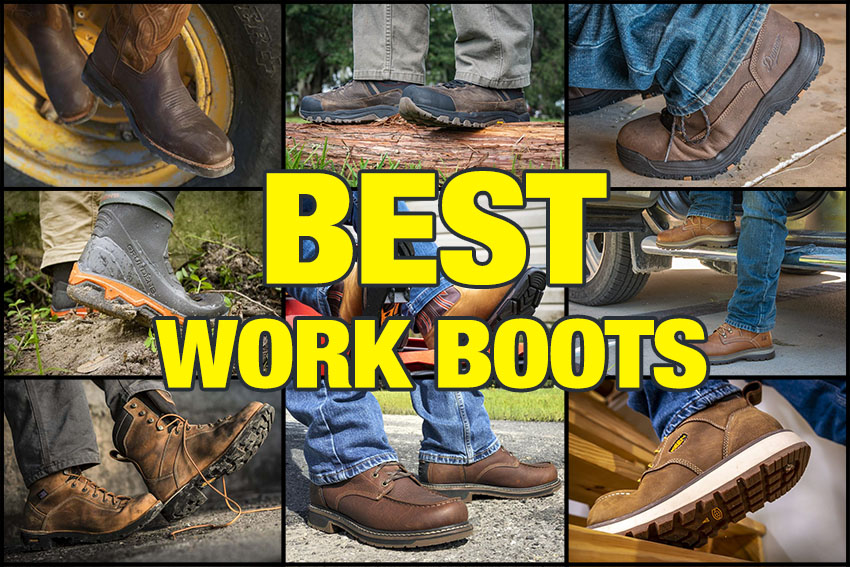
This image is property of www.protoolreviews.com.
When working on a roof, having proper slip resistance on your work boots is crucial to ensure your safety. The last thing you want is to lose your balance and risk a dangerous fall. That's why the slip resistance of work boots is a crucial factor to consider when choosing the best pair for roofing.
Outsole Traction
One important aspect of slip resistance is the outsole traction. A good work boot should have a specially designed outsole that offers excellent grip on various surfaces, including wet or slippery roofs. Look for boots with deep, multi-directional lugs that provide optimal traction, helping you maintain stability and balance.
Oil and Chemical Resistance
Roofing often involves exposure to various chemicals and materials. Therefore, it is essential to choose work boots that are oil and chemical resistant. This feature ensures that your boots won't deteriorate or become slippery when in contact with substances commonly found on roofs, such as asphalt or solvents.
Lug Patterns
The lug patterns on the outsole play a significant role in slip resistance. Boots with aggressive lug patterns have better grip, reducing the risk of slips and falls. These patterns help channel water and debris away from the sole, enhancing traction even in challenging conditions.
Slip-Resistant Soles
Another important consideration is the slip-resistant soles of the work boots. Look for boots that are specifically designed to provide superior slip resistance, ensuring stability on wet or uneven surfaces. These soles are often made from rubber or other non-slip materials, providing excellent traction and reducing the chances of accidents.
ASTM F2913-19 Standard
To make an informed decision, it's essential to check if the work boots meet the ASTM F2913-19 standard for slip resistance. This standard ensures that the boots undergo rigorous testing and meet specific criteria for slip resistance. Choosing boots that meet this standard gives you added confidence in their ability to keep you safe while working on roofs.
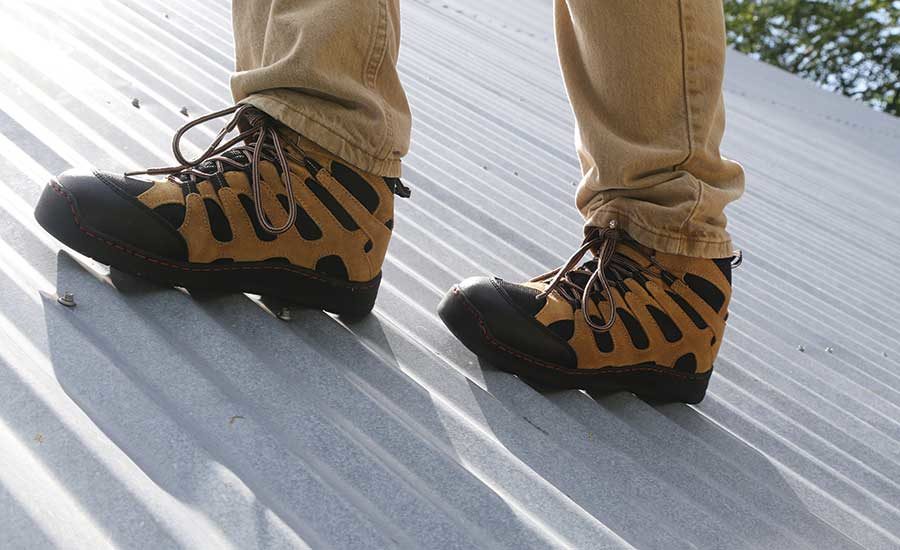
This image is property of www.roofingcontractor.com.
## 6. Waterproofing
When it comes to roofing, having waterproof work boots is crucial to keep your feet dry and comfortable throughout the day. There are several factors to consider when selecting work boots that offer optimal waterproofing.
6.1 Gore-Tex Membrane
One popular waterproofing feature found in top work boots is the Gore-Tex membrane. This special material is designed to keep water out while allowing moisture to escape, ensuring your feet stay dry and sweat-free.
6.2 Waterproof Leather
Another option for waterproof work boots is boots made from waterproof leather. This type of leather is treated with special coatings or wax to repel water and prevent it from seeping in, giving you added protection during wet weather conditions.
6.3 Seam Sealing
Properly sealed seams are essential when it comes to waterproofing work boots. Quality boots often have their seams sealed with waterproof adhesive or tape, preventing water from penetrating through the stitching and reaching your feet.
6.4 Water-Repellent Treatments
Some work boots are treated with water-repellent coatings or sprays, which add an extra layer of protection against moisture. These treatments enhance the boots' waterproofing capabilities, making them ideal for roofing work.
6.5 Protection from Moisture
Apart from waterproofing features, work boots for roofing should also provide adequate protection against moisture in general. Look for boots with moisture-wicking linings or cushioned insoles that help absorb sweat and keep your feet dry and comfortable throughout the day.
When choosing the best work boots for roofing, ensure they have reliable waterproofing features such as a Gore-Tex membrane, waterproof leather, properly sealed seams, water-repellent treatments, and protection from moisture. These features will keep your feet dry and protected, allowing you to focus on your job without any discomfort or distractions.
7. Insulation
Roofing work often exposes you to extreme weather conditions, including freezing temperatures. Therefore, proper insulation is crucial when choosing work boots for roofing. Insulated boots will keep your feet warm and protect you from frostbite or hypothermia.
7.1 Thinsulate Insulation
Thinsulate insulation is a popular choice for work boots. It provides exceptional warmth without adding excessive bulk or weight to the boot. This lightweight insulation material traps air molecules, effectively retaining heat while allowing moisture to evaporate, keeping your feet comfortably dry.
7.2 Thermal Reflective Lining
To further enhance insulation capabilities, choose boots with a thermal reflective lining. This innovative technology reflects body heat back to your feet, minimizing heat loss and maximizing warmth.
7.3 Insulated Boot Construction
Look for work boots with insulated construction, such as additional layers or materials that provide extra insulation. This construction helps to create a barrier against cold air and keeps your feet cozy throughout the day.
7.4 Cold-Weather Performance
Consider boots specifically designed for cold-weather performance. These boots often feature advanced insulation technologies, such as closed-cell foam or synthetic fibers, to provide superior protection against low temperatures.
7.5 Breathable Insulation
While insulation is essential, you also want your work boots to be breathable to prevent excessive sweating and discomfort. Look for boots with breathable insulation, such as moisture-wicking liners or perforated materials, to ensure adequate airflow and moisture management.
When choosing work boots for roofing, prioritize proper insulation to keep your feet warm and protected in harsh weather conditions. Thinsulate insulation, thermal reflective lining, insulated construction, cold-weather performance, and breathable insulation are all important factors to consider when selecting the best work boots for roofing.
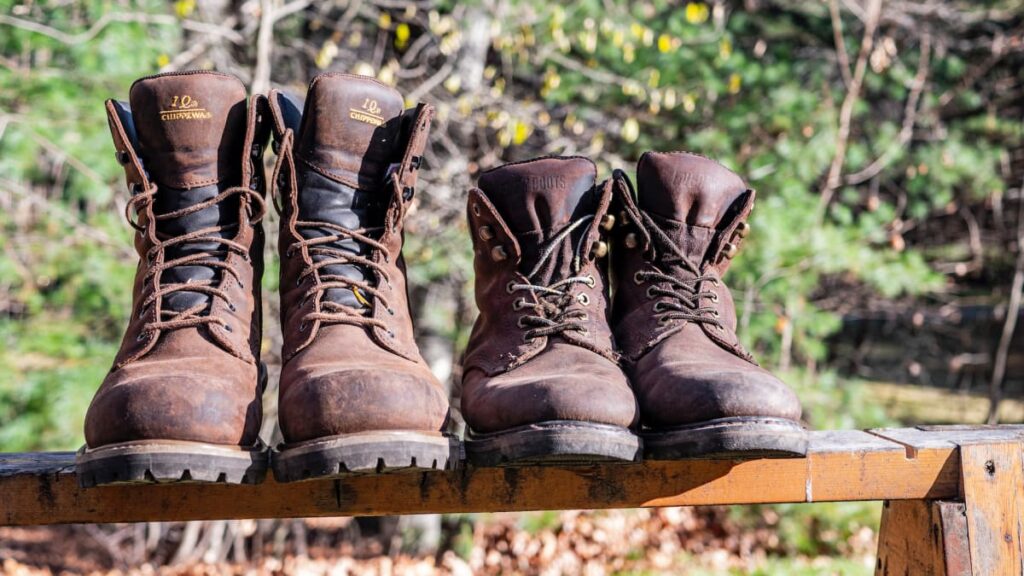
This image is property of reviewed-com-res.cloudinary.com.
## 8. Breathability When it comes to choosing the right work boots for roofing, breathability is a crucial factor to consider. Roofing work often exposes you to extreme temperatures and conditions, so you need boots that can keep your feet cool and dry throughout the day.
8.1 Moisture-Wicking Lining
Look for work boots that feature a moisture-wicking lining. This special lining helps to draw away sweat and moisture from your feet, preventing them from becoming damp and uncomfortable. It also helps to reduce the risk of odors caused by bacteria growth.
8.2 Ventilation Systems
Some work boots come equipped with ventilation systems that promote airflow and enhance breathability. These systems usually consist of tiny perforations or mesh panels strategically placed in the upper part of the boot. They allow air to circulate, preventing heat buildup and allowing your feet to breathe.
8.3 Breathable Upper Materials
Consider work boots with uppers made from breathable materials such as leather or synthetic mesh. These materials allow air to flow freely, keeping your feet cooler and drier.
8.4 Cooling Technologies
Certain work boots incorporate cooling technologies like gel inserts or cushioned footbeds that provide an additional layer of comfort and help regulate foot temperature.
8.5 Anti-Bacterial Properties
Lastly, seek out work boots with anti-bacterial properties. These boots are designed to inhibit the growth of bacteria, reducing the chances of foot odor and infections.
Remember, when it comes to roofing work, keeping your feet cool and dry is essential. Prioritize breathability when selecting the best work boots for your roofing needs.
10. Price
When it comes to purchasing work boots for your roofing job, considering the price is an essential factor. You want to find a pair that offers high-quality protection without breaking the bank. In this section, we will explore different price ranges and what they can offer you.
10.1 Budget-Friendly Options
If you're on a tight budget, there are still work boots available that provide decent protection. These options are typically made from synthetic materials, which makes them more affordable. While they may lack some of the features offered by higher-end boots, they can still provide adequate safety and comfort.
10.2 Mid-Range Work Boots
For those who are willing to spend a bit more, mid-range work boots offer a balance between cost and quality. These boots are often made from durable materials like leather and may include additional features such as reinforced toes and grip-enhancing outsoles. They provide good support and protection while still being affordable.
10.3 High-End Professional Boots
If you are a professional roofer or work in hazardous conditions, investing in high-end work boots is a wise choice. These boots are typically made from top-grade materials, providing superior durability and protection. They often include features like puncture-resistant soles, waterproofing, and insulation for extreme weather conditions.
10.4 Value for Money
When considering the price of work boots, it's important to evaluate the overall value for money. Look for boots that offer a combination of quality, durability, and features at a fair price. Consider the specific needs of your roofing job and choose boots that will meet those requirements within your budget.
10.5 Warranty and Customer Reviews
Lastly, it's always wise to consider the warranty and customer reviews when purchasing work boots. A good warranty can provide peace of mind in case of any defects or issues with the boots. Additionally, reading customer reviews can give you insights into the actual performance and durability of the boots, helping you make an informed decision.
In conclusion, while price is an important consideration when purchasing work boots for roofing, it's essential to find a pair that offers the right balance of quality, durability, and features for your specific needs. Whether you opt for budget-friendly options or invest in high-end professional boots, prioritize finding a pair that provides the best value for money and offers the necessary protection to keep you safe on the job.





